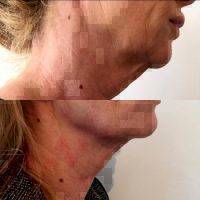Different Types Of Facelift Procedures
There are many different types of facelifts on the market.
In general there are 5 different types:
Non surgical lift: uses volumizers in combination with Botox to provide a lift of facial tissues without surgery
Mini facelift: addresses primarily changes with the jawline and jowling; some patients get a mild improvement in the neck
MiniNeck or Necklift: addresses primarily changes with the neck, some patients get a mild improvement in the jowl.
MidFace lift: lifts the cheek tissues and improves the nasolabial folds which can sometimes help jowling in some patients
Facelift: a combination procedure which will address all of the above: cheek, jowl, neck, and volume if needed.
There are different types of lifts, so it can be very confusing.
The gold standard is still a facelift to address aging changes of the lower face and neck. Mini lifts and mid face lifts are most suited to patients with mild aging changes.
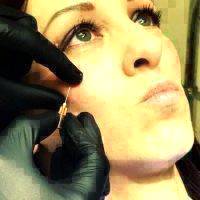
Bio Botox Non Surgical Facelift
Mid face lifts re suspend the cheek area. This area is also well addressed with fat grafting, which is my preference. Mini lifts typically are short incision lifts and primarily skin tightening only. I would recommend consultation with a facial plastic surgeon to discuss the best option for you. (Elizabeth Whitaker, MD, FACS, Atlanta Facial Plastic Surgeon)
Although each type of facelift has its own nuances, the general differences between them are related to the regions of the face that each treats. A traditional full facelift targets the lower two-thirds of the face, making it the most popular option.
It can treat jowls, a double chin, loss of volume in the cheeks, and wrinkles around the mouth.
A midface lift is a less popular option that improves the area above the mouth, and a mini facelift is best for patients with more mild signs of aging or those who have previously had a full facelift.

Botox Injections For Face Wrinkles
But these definitions are very general, and one of the great things about facelift surgery is that it can be completely customized based on your own unique preferences. I recommend seeing a board-certified plastic surgeon for an in-person consultation to learn more. (James N. Romanelli, MD, FACS, Long Island Plastic Surgeon)
Today there are all sorts of names, nicknames and special slogans for the various types of Face Lifts that can be very confusing.
A Face Lift is a plastic surgery procedure that’s designed to make an incision around the ear and typically under the chin for the sole purpose of removing excess fat and skin from the face and neck.
There are various types of Face Lifts and even different names for the same Face Lift procedure, so when reading or researching Face Lifts you may want to concentrate on what the Face Lift procedure says it does as a way of distinquishing between them.

Botox Injections In Lower Face
Long or short incision. Underlying SMAS muscle, skin only, uses sutures or threads, subperiosteal layer. Amount of skin dissection.
Will drains be required after the Face Lift and what’s the realistic time of recovery….days, weeks or months. What is the goal of the Face Lift or more specifically what’s done during that particular type of Face Lift?
Traditional Facelifts have longer incisions that extend from the temporal hairline, around the front of the ear, into the crease behind the ear finally ending within the posterior hair.
The amount of skin dissection is variable as is the attention to the underlying SMAS muscle layer than can be folded over with sutures, cut/lifted and trimmed or not touched at all. Drains are typical as are large pressure dressings.
The recovery is 10 days and it can take 6 months or longer for all the swelling, lumps and bumps to be finally gone. I know because I’ve done this type of Face Lift for over 20 years.
Mini Face Lifts as their name suggest are smaller versions of the aforementioned traditional Face Lift with shorter incisions, less skin dissection, same issues with SMAS..some suture it, some lift/cut while others do nothing with it and simply remove skin.
These Face Lifts have all sorts of names weekend Face Lift, Lifestyle Lift, S Lift, C Lift and my own Palmer Celebrity Face Lift. The benefit of these types of Face Lifts is they are easier to go through for the patients.
Quicker surgery, often as little as 60-90 minutes, quick recovery measured in hours or days and no hair loss because there doesn’t need to be any incisions inside the hair. These Face Lifts are great, in my opinion, for active people who aren’t interested in drastic changes, long recovery or long surgeries but rather want to look, fresh and naturally attractive. (Francis R. Palmer, III, MD, Beverly Hills Facial Plastic Surgeon)
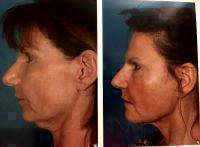
Face Lift With Neck Lift Photo
There are a variety of different facelift type procedures to rejuvenate the face. The names often vary, which can be confusing to interested men and women. In addition, some doctors have renamed or rebranded styles of facelifts for marketing reasons, which further confuses the picture.
In short, a facelift is a spectrum of procedures that elevates and rejuvenates the lower face, cheeks, and neck. The extent of the procedure should be tailored to fit your own individual needs. Every persons face ages differently, and every face should be treated differently.
For some people, a more extensive procedure is needed. This would be called a full facelift and may result in longer resultant scars and longer recovery time. For people with earlier or less severe aging, a mini-facelift may be appropriate.
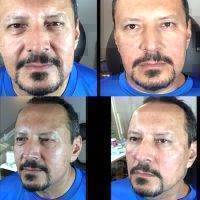
Male Non Surgical Facelift Before And After
This is also called a short scar facelift by some. This will typically limit the length of the scars to only in front of the ears and avoid the scar behind the ear. It is best used when the neck needs only limited improvement.
Between these two ends of the spectrum, there are a variety of facelifting procedures. The goal is to maximize your results while limiting the recovery time and resultant scars. Again, this can be tailored to fit your individual needs.
Midfacelift procedures are different. These are used to elevate the medial, or central, cheeks. These can be performed either with an endoscope or through the lower eyelid. They do nothing to treat the jawline, neck, or jowls.
Hopefully this helps to clarify some of the confusion. As always, a consultation with a board certified plastic surgeon with experience in the different types of lifts can help you understand the options for you. (Jeffrey Rockmore, MD, Albany Plastic Surgeon)
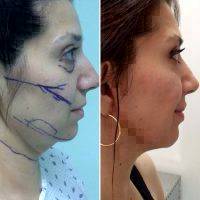
Mid-face Lift Before And After Photos
Different types of “Facelift”
The terminology around facelift surgery can be confusing, especially in this era of giving clever names to the surgery. Basically a shorter scar facelift surgery can be helpful as long as the problems are more limited and some Plastic Surgeons might refer to this by many different names such as a Mini Facelift.
Even among Plastic Surgeons a name such as Mid Facelift can mean different procedures . So the most important goal should be to find an experienced, Board Certified Plastic Surgeon and find out what would work for you and then call it what you want.
Beware of surgical procedures that cut corners ( such as lack of monitering and anesthesia providers) to protect your safety (G. Wesley Price, MD, Chevy Chase Plastic Surgeon)

Mid-face Lift Before And After Pictures
Best Type of Facelift
Although there are different types of facelifts, the most important factor is the surgeon.
Each surgeon will have individual talents, artistic ability, and perform technical different procedures for your facial rejuvenation. Seek a surgeon with ability to make both robust changes which appear natural. (Anil R. Shah, MD, Chicago Facial Plastic Surgeon)
Differ takes on the lift
So these are all different takes on the “facelift” as a procedure. That means we can adjust the depth of surgery, the length of the flap that is raised and thus the recovery time. That being said, it also does affect the longevity and the amount of movement you can gain from the tissues.
The best bet is to see a surgeon, build a relationship and be clear about what you are trying to accomplish. Most of us can perform all the different types of lifts. It is about finding the right fit for each specific patient.
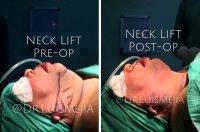
Neck Lift Surgery Before And After Photo
This is really when the art of medicine comes into play. Facelifting is not a one size fits all procedure so I think it is key to be able to adapt to the patient’s specific needs and goals.
This includes the inability to have a significant downtime. (Benjamin Caughlin, MD, Chicago Facial Plastic Surgeon)
What type of facelift?
There is a bewildering array of terminology and different techniques available, all included within the term facelift. The choice of technique is often determined by surgeon preference as well as the needs and requirements of the individual patient.
Rather than relying on a catchy name, often used for marketing purposes rather than medical, your surgeon should explain exactly how the surgery is to be performed, the scars and the technique used within the face.

Neck Lift Surgery Type
This should give you a clear idea of the expected result and recovery time. (James Murphy, FRCS(Plast), Manchester Plastic Surgeon)
Facelift types
There are many names given to the procedures used for facial rejuvenation. It is interesting that the anatomy of the face is very similar in all patients yet there are so many names for seemingly accomplishing the same results.
The purpose of any lifting technique is to reduce neck fat and tighten (smooth) the jawline. The trick is to get it to stay there. Some surgeons use mini lifts, short scars, single stitching, S lifts, Lifestylelifts, etc. to make them sound trendy, state-of the-art, less expensive, and less painful. Regardless, the end results are a facelift. (Timothy Fee, MD, Jacksonville Plastic Surgeon)
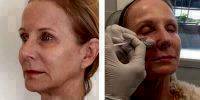
Non Invasive Botox Facial Photos
Different tools for different problems
It’s best to think of the face as a region of the body with multiple smaller areas, or subunits, that can be treated together or separately.
The bow, the upper and lower eyelids, the cheek, the lower face, and the neck may each be addressed individually or together.
The rejuvenation of one area may or may not have an effect on another area, but it is important to remember that one type of operation on one area is not interchangeable for another type of operation on another area.
What do I mean by this? The word “face lift” is a vague term used by many people to mean many things. When most people speak of a face lift, they are talking about a lower face and neck rejuvenation with the classic incision from the side burn around the earlobe and on or into the hairline behind the ear.

Non Surgical Face Lift With Botox
Some surgeons, like me, often perform a cheek lift at the same time as the lower face lift by re-suspending the soft tissue that was once at the cheekbone, back to its original, youthful position.
The cheek lift can be performed without the face lift, through an incision at the lower eyelid. his is a smaller incision, with less dissection than the methods used with the classic facility. But alone, the cheek lift does not provide the improvement to the lower face.
Your plastic surgeon has a lot of tools to perform a great variety of rejuvenation procedures on you. Every patient is different, and while some patients may benefit from a cheek lift alone and others from a face lift, some may require both or neither.
Bring your concerns to your board certified plastic surgeon, and listen to the suggestions that she or he has to address your goals. Get several opinions in order to find the doctor that you are most comfortable with, and the procedure that makes the most sense to you after your discussions.(Adam David Lowenstein, MD, FACS, Santa Barbara Plastic Surgeon)
Different types of lifts
A midface lift elevates your upper cheeks and the area under the eyes. It is a type of minilift. A cheek lift, where the outer cheek is lifted, is the most common type of mini lift.
A neck lift is also a minilift. Combine a neck lift and a cheek lift and you get a full lower facelift, the most common type of full facelift. (Stuart H. Bentkover, MD, Boston Facial Plastic Surgeon)
Different Facelifts
A facelift focuses on the full face and will address the loss of muscle tone in the lower face jowls, sagging in the mid face that creates fallen fat pockets, neck laxity, as well as deep creases around the mouth and eye area.
A brow lift may also be considered for some undergoing a facelift for the most optimal results. A mini-facelift, unlike a traditional facelift, addresses specific targeted areas such as lower eyelids, mid cheek, jawline and neck.
It is designed for a younger patient who doesn’t necessarily require a full lift. This procedure requires smaller incisions and less recovery time. Both types of lifts are customized to the patient and should be discussed with an experienced, board certified plastic surgeon. (Jeffrey W. Hall, MD, Austin Plastic Surgeon)
